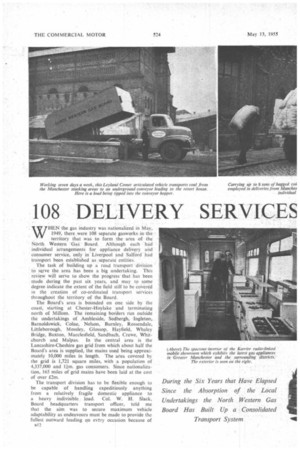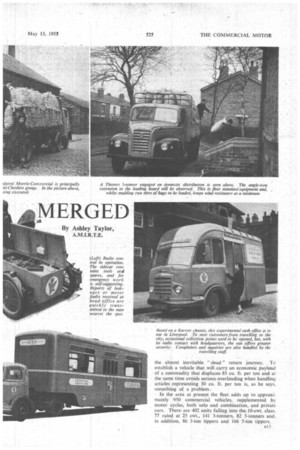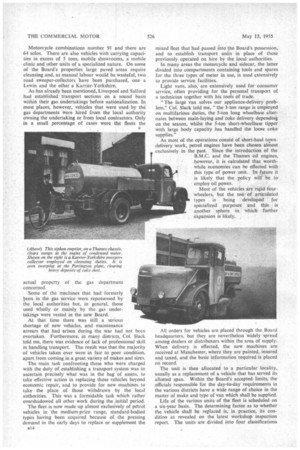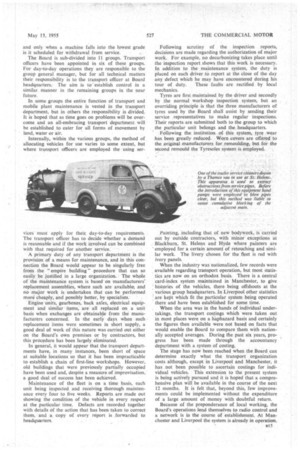108 - DELIVERY SERVICES W HEN the gas industry was nationalized in
Page 46

Page 47

Page 48

Page 49

If you've noticed an error in this article please click here to report it so we can fix it.
May, 1949, there were 108 separate gasworks in the territory that was to form the area of the North Western -Gas Board. Although each had individual arrangements for appliance delivery and consumer service, only in Liverpool and Salford had transport been established as separate entities.
The task of building up a road transport division to serve the area has been a big undertaking. This review will serve to show the progress that has been made during the past six years, and may to sort1e. degree indicate the extent of the field still to be covered in the creation of co-ordinated transport services throughout the territory of the Board.
The Board's area is bounded on one side by the coast, starting at Chester-Hoylake and terminating north of Miami. The remaining borders rim outside the undertakings of Arnbleside, Sedbergh., -Ingleton, Barnoldswick, Colne, Nelson, Burnley, Rossendale, Littleborough, Mossley, Glossop, Hayfield, Whaley Bridge, Buxton, Macclesfield, Sandbach, Crewe, Whitchurch and Malpas. In the central area is the Lancashire-Cheshire gas grid from which about half the Board's area is supplied, the mains used being approximately 10,000 miles in length. The area covered by the grid is 1,721 square miles, with a population of 4,337,000 and am. gas consumers. Since nationalization, 165 miles of grid mains have been laid at the cost of over £2m.
The transport division has to be flexible enough to be capable of handling expeditiously anything from a relatively fragile domestic appliance to a heavy indivisible. load. Col. W. H. Slack, Board headquarters transport officer, told me that the aim was to secure maximum vehicle adaptability as endeavours must be made to provide the fullest outward loading on evzry occasion because of
n1/ the almost inevitable " dead" return journey. To establish a vehicle that will carry an economic payload of a commodity that displaces 85 Cu. ft. per ton and at the same time avoids serious overloading when handling articles representing 30 Cu. ft. per ton is, as he says, something of a problem.
In the area at present the fleet adds up to approxi mately 950 commercial vehicles, supplemented by motor cycles, both solo and combination, and private cars. There are 402 units falling into the 10-cwt. class.
77 rated at 25 cwt., 141 3-tonners, 82 5-tonners and.
in addition, 86 3-ton tippers and 166 5-ton tippers. Motorcycle combinations number 91 and there are 64 solos. There are also vehicles with carrying capacities in excess of 5 tons, mobile showrooms, a mobile clinic and other units of a specialized nature. On some of the Board's properties large paved areas require cleansing and, as manual labour would be wasteful, two road sweeper-collectors have been purchased, one a Lewin and the other a Karrier-Yorkshire.
As has already been mentioned, Liverpool and Salford had established transport sections on a sound basis within their gas undertakings before nationalization. In most places, however, vehicles that were used by the gas departments were hired from the local authority owning the undertaking or from local contractors. Only in a small percentage of cases were the fleets the
actual property of the gas department concerned.
Some of the machines that had formerly been in the gas Service were repossessed by the loyal authorities but, in general, those used wholly or mainly by the gas undertakings were vested in the new Board.
At that time there was still a serious shortage of new vehicles, and maintenance arrears that had arisen during the war had not been overtaken. Furthermore, in man Y districts, Col. Slack told me, there was evidence of lack of professional skill in handling transport. The result was that the majority of vehicles taken over were in fair to poor condition, apart from coming in a great variety of makes and sizes.
The main task confronting those who were charged with the duty of establishing a transport system was to ascertain precisely what was in the bag of assets, to
take effective action in replacing those vehicles beyond economic repair, and to provide for new machines to take the place of those withdrawn by the local authorities. This was a formidable task which rather. overshadowed all other work during the ,initial period.
The fleet is now made up almost exclusively of pdtrol vehicles in the medium-price range, standard-bodied types having been acquired because of the pressing
demand in the early days to replace or supplement the B14
mixed fleet that had passed into the Board's possession, and to establish transport units in place of those previously operated on hire by the local authorities.
In many areas the motorcycle and sidecar, the latter divided into compartments containing tools and spares for the three types of meter in use, is used extensively to provide service facilities.
Light vans, also, are extensively used for consumer service, often providing for the personal transport of a technician together with his tools of trade.
The large van solves our appliance-delivery problem," Col. Slack told me, "the 34on range is employed on multifarious duties, the 5-ton long wheelbase alternates between main-laying and coke delivery depending on the season, whilst the 5-ton short-wheelbase tipper with large body capacity has handled the loose coke supplies"
As most of the operations consist of short-haul towndelivery, work, petrol engines have been chosen almost exclusively in the past. Since the introduction of the B.M.C. and the Thames oil engines, however, it is calculated that worthwhile economies can be effected with this type of power unit. In future it is likely that the policy will be to employ oil power.
Most of the vehicles are' rigid fourwheelers, but the use of articulated types is being developed for specialized purposes and this is another sphere in which further expansion is likely.
All orders for vehicles are placed through the Board headquarters, but they are nevertheless widely spread among dealers or distributors within the area of supply.. When delivery is effected, the new machines are received at Manchester, where they are painted, insured and taxed, and the basic information required is placed on record.
The unit is then allocated to a particular locality, usually as a replacement of a vehicle that has served its allotted span. Within the Board's accepted limits, the officials responsible for the day-to-day requirements in the various districts have a. wide range of choice in the matter of make and type of van which shall be supplied.
Life of the various units of the fleet is scheduled on a six-year basis. The determining factor as to whether the vehicle shall be replaced is, in practice, its condition as revealed on the latest workshop inspection report. The units are divided into four classifications and only when a machine falls into the lowest grade is it scheduled for withdrawal from service.
The Board is sub-divided into 11 groups. Transport officers have been appointed in six of these groups. For day-to-day operations they are responsible to the group general manager, but for all technical matters their responsibility is to the transport officer at Board headquarters, The aim is to'establish control in a similar manner in the remaining groups in the near future.
In some groups the entire function of transport and mobile plant maintenance is vested in the transport department, but in others the responsibility is divided. It is hoped that as time goes on problems will be overcome and an all-embracing transport department will be established to cater for all forms of movement by land, water or air.
Internally, within the various groups, the method of allocating vehicles for use varies to some extent, but where transport officers are employed the using ser vices must apply for their, day-to-day requirements. The transport officer has to decide whether a demand is reasonable and if the work involved can be combined with that required for another service.
A primary duty of any transport department is the provision of a means for maintenance, and in this connection the Board would appear to be singularly free from the "empire building " procedure that can so easily be justified in a large organization. The whole of the maintenance system is based on manufacturers' replacement assemblies, where such are availabie; and no major work is undertaken that can be performed more cheaply, and possibly better, by specialists.
Engine units, gearboxes, back axles, electrical equipment and similar items, are all replaced on a unit basis when exchanges are obtainable from the manufacturers concerned. In the early days when such replacement items were sometimes in short supply, a goad deal of work of this nature was carried out either on the Board's own premises or by contractors, but this procedure has been largely eliminated.
In general, it would appear that the transport departments have, in many instances, been short of space at suitable locations so that it has been impracticable to establish a chain of first-line workshops. However, old buildings that were previously partially occupied have been used and, despite a measure of improvisation, a good deal of success has been achieved.
Maintenance of the fleet is on a time basis, each unit being inspected and receiving thorough maintenance every four to five weeks. Reports are made out showing the condition of the vehicle in every respect at the particular time. Defects are recorded together with details of the action that has been taken to correct them, and a copy of every report is forwarded to headquarters. Following scrutiny of the inspection reports, decisions are made regarding the authorization of major work. For example, no decarbonizing takes place until the inspection report shows that this work is necessary. In addition to the maintenance system, the duty is placed on each driver to report at the close of the day any defect which he may have encountered during his tour of duty. These faults are rectified by local mechanics.
Tyres are first maintained by the driver and secondly by the normal workshop inspection system, but an overriding principle is that the three manufacturers of tyres used by the Board shall assist by sending their service representatives to make regular inspections. Their reports are submitted both to the group to which the particular unit belongs and the headquarters.
Following the institution of this system, tyre wear has been greatly reduced. Worn covers are offered to the original .manufacturers for remoulding, but for the second remould the Tyresoles system is employed.
Painting, including that of new bodywork, is carried out by outside contractors, with minor exceptions at Blackburn, St. Helens and Hyde where painters are employed for a certain amount of retouching and similar work. The livery chosen for the fleet is red with ivory panels.
When the industry was nationalized, few records were available regarding transport operation, but most statistics are now on an orthodox basis. There is a central card-index system maintained in Manchester, to give histories of the vehicles, there being offshoots at the various group headquarters. In Liverpool other statistics are kept which fit the particular system being operated there and have been established for some time.
When the area was in the hands of individual undertakings, the transport costings which were taken out in most places were on a haphazard basis and certainly the figures then available were not based on facts that would enable the Board to compare them with nationally accepted averages. During the past six years, progress has been made through the accountancy department with a system of costing.
The stage has now been reached when the Board can determine exactly what the transport organization costs although, except in Liverpool and Manchester, it has not been possible to ascertain costings for individual vehicles. This extension to the present system is being actively pursued and it is hoped that a comprehensive plan will be available in the course of the next 12 months. It is felt that, beyond this, few improvements could be implemented without the expenditure of a large amount of money with doubtful return.
Because of the preponderance of local working, the Board's operations lend themselves to radio control and a network is in the course of establishment. At Manchester and Liverpool the system is already in operation.




























































































